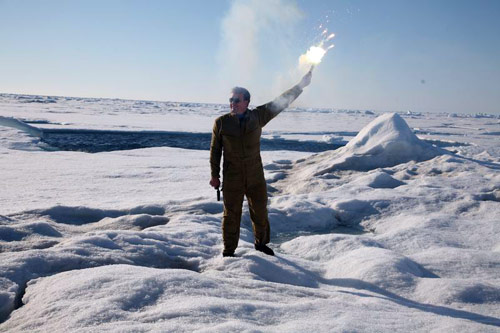MVK ranks among the first at the North Pole!
A representative of MVK: photographer Alexey Nagaev, pilots of the helicopter, and ice explorers were the first of the Arctika-2007 expedition who stepped onto the Earth. On the sparkling snow at the pole, our photographer outlined the company’s name.

The MVK International Exhibition Company is a media partner of the high-latitude Arctic expedition. The expedition leader, Director General of MVK, Alexey Shaburov noted that participation in Arctika-2007 was an essential step in the development of the company’s image projects. “Information management of the expedition is to be the next logical step in the development of the Mobile polar museum, The Role of HISTORY in life and business, which covers the history of the Arctic exploration, from Papanin and his team’s landing on the ice floe 70 years ago and up to the feats of modern polar explorers, such as Artur Chilingarov”.
A helicopter with some scientists from the Petersburg Institute of the Arctic and Antarctic, and a representative of MVK – photographer Alexey Nagaev on board, has flown today to explore the ice. The purpose of the flight was to find an ice-hole in the North Pole for the Mir submersibles' test dive.
Pilot, Vadim Bazykin masterfully landed the Mi-8 helicopter on the ice in great spaces of the Arctic. On board were the ice explorers: Sergey Frolov, Head of the ice navigation laboratory of the Arctic and Antarctic Research Institute, and Alexander Kim, a scientist working on the atomic icebreaker Russia. The landing was short – just five minutes. First, the helicopter hovered above the ice surface completely covered with small fresh water pools, which appear on the surface of the ice in the warmer months. The polar explorers jumped onto the ice. They smiled on the landing, but the helicopter hovered, not turning off the engines.
Flight engineer, Evgeny Zakutilin fired a volley from a pistol. Under the “Hurray!” he lit the Olympic flame of Chilingarov’s team on top of the world.
Ice researcher, Sergey Frolov celebrated his birthday there. He was there for the tenth time. With the help of the ice navigation laboratory of the Arctic and Antarctic Research Institute, and scientific developments for the first time in history in 2005, the scientific expedition vessel Akademik Fedorov reached the North Pole without the help of an icebreaker.
“The ice is not very thick in these areas”, says Frolov, showing the maps of ice conditions. “We are going into one-two-year ice, no more than 1,5 meters thick” Ice explorers give recommendations to the expedition management – where it is better and easier to go through the ice to get around the most hummocky areas, ice bridges, and multi-year ice. Part of the way the caravan moved in the traces, if I may say so, – along the path of ice-breakers which had been there earlier.
The main purpose of the ice exploration was to find an ice-hole, suitable for the Mir submersibles diving at the bottom of the Arctic Ocean at the North Pole. Not an easy task. Even in this time of the year, say ice experts, the cohesion of the ice cover is of at least 9 points. It means that almost the entire surface is covered with an ice shell. However, a cul-de-sac was found. It is quite small in size the Mir-1 and the Mir-2 teams will have to show the highest art maneuvers to get out from under the ice in the open water.

Ice exploration 12 kilometers from the expedition’s direction discovered a trail of the ice-breaker Yamal which had recently been there with the tourists. Passage of such a beaten path allows you to move faster on the ice, which helped the caravan of ships to go faster to the cherished point of 90º Nord.
Alexey Nagaev, the MVK expedition photographer was there for the first time.
“I am delighted”, he said “that despite all the obstacles we had to overcome to get into the helicopter, I found myself in this magical connection with the meridian point! Here, wherever you look – the South and there is no such a thing as longitude”.
*** Let us recall that a comprehensive high-latitude expedition the Arctika-2007 was launched in April 2007. It is of paramount importance for Russia as the biggest expedition in the Arctic in recent years. More than a hundred scientists from ten research institutions in several months have been conducting extensive research.

In the framework of the Arctika-2007, the Mir-1 and the Mir-2 deep manned submersibles have to sink to the bottom of the Arctic Ocean and set the Russian Flag. Soil samples and specimens of fauna from the ocean bed will help to define the boundaries of the Arctic shelf.
“We want to prove that Russia is A great polar power”, stressed the Head of the Arctic deep-sea expedition, the Special Presidential Envoy for the International Polar Year, Artur Chilingarov.
